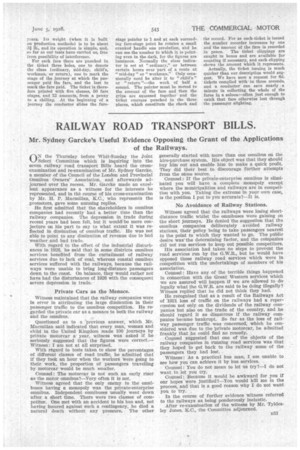SIMPLIFYING BUS-TICKET ISSUE.
Page 56

Page 57

If you've noticed an error in this article please click here to report it so we can fix it.
A New Machine for the Issue of Tickets and the Recording of the Fares Collected. Claim to Increased Revenue and Reduced Cost.
MHE leading passenger-carrying con
cerns have for a long time sought for some improvement upon the present system of checking and recording the collection of fares on trams, buses and other vehicles on which the fares are made en route. The present practice is to issue to each conductor a box containing a stock of tickets, a bell punch and a waybill. Each conductor has a continuous series of numbers to his tickets, so that when he has run through a packet of penny fare tickets ending with (let us say) Gt. 4500, a packet commencing Gt. 4501 will be found ready for him in his box. Obviously, this means that at the ticketissuing office the stock of tickets in all varieties (ordinary, mid-day, workmen's, child's and return, in all fares from a penny to a shilling, and the interchange tickets) must be kept apart from the tickets for another conductor. Let this be multiplied by two (for each conductor has two complete outfits issued on alternate days so as to allow for checking, recording, replenishing and resetting of the punch-recording dials), and then again by 10,000, the number of conduc
a30 tors employed, and it will be seen that the task imposed upon a ticket-issuing office is vast. The L.G.O.C. has about 4,500 buses on the road, and issues over four million tickets on every ordinary day and over six million on a Bank Holiday, and to meet the needs of the services about 3,000 or 3,500 different kinds of ticket must be stocked.
The waybill has to show all the varieties of the tickets and the commencing numbers of each kind, and at the end of the day the conductor must fill in the finishing numbers, and these have to be checked and the total recorded proceeds checked against the amount handed in.
A ticket-issuing machine would much simplify the work. Two would be allotted to each conductor to be used on alternate days, and to him would be issued only a universal ticket in rolls of 500 each, and his machine would show the number issued throughout the working day and the amount of money taken. Such a machine is the new Comley ticket register, which has recently been shown to us by the inventor, who has been known to us for many
years. Its weight (when it is built on production methods) is to be about a lb., and its operation is Simple, and, so far as our tests have carried us, free from possibility of interference.
For each fare there are punched in the ticket three holes, one to denote the class (ordinary, mid-day, child's, workman, or return), one to mark the stage of the journey at which the passenger paid the fare, and the last to mark the fare paid. The ticket is therefore printed with five classes, 50 fare stages, and 12 amounts, from a penny to a shilling. At the beginning of a journey the conductor slides the fare
stage pointer to 1 and at each succeeding fare-stage point he rotates a small cranked haudle one revolution, and he can see the number to which it is pointing even in the dark, for the figures are luminous. Normally the class indicator is set at " ordinary," or between certain hours over part of a route at " mid-day " or "workman." Only occasionally need he alter it to "child's" or "return "—the work of half a second. The pointer must be moved to the amount of the fare and then the grips are squeezed together and the ticket emerges punched in the three places, which constitute the check and
the record. For as each ticket is issued the number recorder increases by one and the amount of the fare is recorded in. pence. The ticket clippings are caught in boxes and are available for counting if necessary, and each clipping shows the amount which it represents.
Actually, the ticket issuing is much quicker than our description would suggest. We have seen a request for 6d. tickets complied with in three seconds, and a conductor can save nearly a minute in collecting the whole of the fares in a saloon—often just enough to catch that fare otherwise lost through the passenger alighting.




















































































































